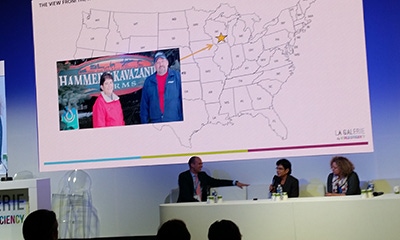
To say Beaver Dam grain farmer Nancy Kavazanjian is busy is an understatement.
Last month she was re-elected to the executive committee of the United Soybean Board. In November, she was re-elected chairwoman of U.S. Farmers and Ranchers Alliance, an organization that is dedicated to leading the national consumer dialogue about how America's food is grown and raised.
Among her responsibilities on the United Soybean Board, Kavazanjian serves as the Sustainability Target Area coordinator. Kavazanjian and her husband, Charles Hammer, grow corn, soybeans and wheat on their 2,100-acre Dodge County farm.

CLIMATE CHANGE PANEL: Nancy Kavazanjian (center) of Beaver Dam spoke on a panel recently at the United Nations Climate Change Conference in Paris.
Kavazanjian also works with the CommonGround initiative in Wisconsin and is one of the key organizers of the annual Wisconsin Corn/Soy EXPO. She is past communications director for the Wisconsin Corn Growers Association.
In December, she was asked to represent the United Soybean Board at the United Nations Climate Change Conference in Paris where she spoke on a panel at a side event about U.S. soybean sustainability.
"For my part, I related how U.S. soybean producers have the ability to help lead in this area, that sustainability is a way of life for us and how we already are working with companies, organizations and our trading partners worldwide to identify and source sustainably produced soybeans," she explains.
Working together, she says, U.S. farmers have reduced greenhouse gas emissions per acre of soybeans by some 20% since the 1980s.
"When you consider yield improvements over that same time, more bushels on each acre, we've cut actual per bushel greenhouse gas emissions in half," Kavazanjian notes. "Total farmland used to grow all crops in the U.S. is down 35%, soil erosion dropped 66%, energy use is down 48% and irrigation water applied to our crops plummeted 42% over the last 30 years. We know that our past efforts, while significant, must be coupled with a commitment to continuously improve our farming practices going forward and we are working on that by sharing our best management practices."
Because more than half of all soybeans grown in the U.S. are exported, Kavazanjian says U.S. soybean farmers developed the U.S. Soybean Sustainability Assurance protocol. The protocol is a certified approach to measuring the sustainability of U.S. soybean production and is based on USDA conservation laws. The data, which includes best practices of more than 275,000 soybean farmers, is based on producer self-audits and is certified annually by USDA.
~~~PAGE_BREAK_HERE~~~
"It is accepted in 14 countries," she says. "Too many people wrongly assume sustainable production only occurs on local or organic farms. U.S. farmers always have been environmentally conscious and today's production practices are the most energy efficient, carbon negative and sustainable models in the world. We have to be sustainable or we go out of business."
Kavazanjian is traveling three weeks out of four. In November, she was in St. Louis, Sacremento and Kansas City before travelling to Paris in early December. Before Christmas, she was back in St. Louis and then flew to Bejing, China, where she did a cooking show and talked to mothers about soybean sustainability. The first three weeks of January include trips to Cuba, Orlando, Fla., and London.
"I love meeting people and representing U.S. farmers," she says. "I talk a lot to chefs and moms."
Another project she is working on for USFRA is spreading agriculture's story by getting the documentary "Farmland" into as many high schools as she possibly can.
"We know Ag in the Classroom (through Farm Bureau) does a great job of reaching elementary students, but we lose them in high School," she explains. "We have developed two science and two social studies lesson plans that anyone can access on DiscoveringFarmland.com and present to high school students. They are 44 minute versions of 'Farmland.'"
Kavazanjian says she is on a mission to get the film into every high school in America to start a conversation about today's farming and ranching and correct the misinformation most teens, as well as adults, have about farming and where their food comes from.
"It's all very exciting to me," she concludes. "Farming is continuously changing and improving and we need to tell our story."
About the Author(s)
You May Also Like






